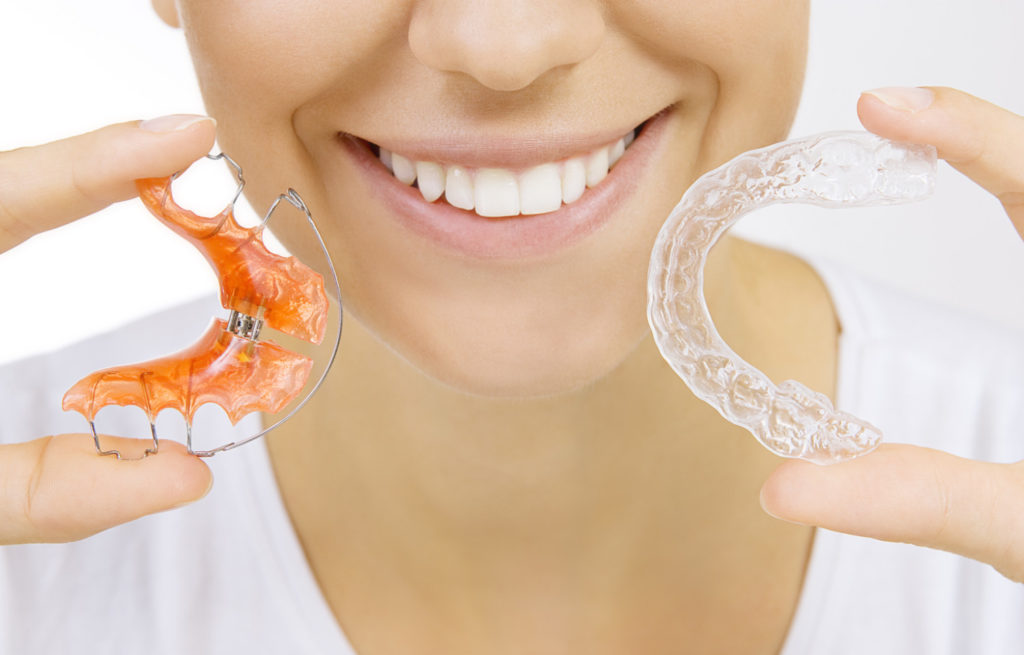When it comes to orthodontic treatment, it does not matter if patients have spent years wearing braces or just a few months in a removable aligner. There must be commitment on the patient’s part to achieve the success of straighter teeth, and when there is, it is worth celebrating! However, only the first step of orthodontic treatment has been completed when the braces are removed, and the next one is every bit as, if not more, important. Once the teeth have been straightened, regular retainer use is necessary to help maintain the patient’s beautiful new smile.
Orthodontic patients at the Coppe + Sears office will often hear Dr. Sears talk about why retainers are such an integral part of keeping the teeth in their new and improved positions. In order to keep the teeth in nearly the same positions as the day the braces came off, we have put together this helpful guide to help patients understand why retainer use is so essential in preventing the teeth from drifting back into their former positions.
What is a retainer?

A retainer is an orthodontic appliance that is molded and designed to fit each individual patient’s mouth. They are made by taking a digital impression of the newly straightened teeth, and then creating the retainer using either a clear plastic material (Essix retainer/mouthguard), or from wire and an acrylic material (Hawley retainer). Each retainer is custom-designed to keep a patient’s smile straight for a lifetime, but this does require dedication on the patient’s part.
Many orthodontists recommend that some type of retainer be worn part-time indefinitely after the teeth have been straightened. This may seem a little overwhelming at first, but retainer wear will easily become a part of a patient’s daily routine. After a period of time, patients in general will only need to wear it overnight a few times per week to keep their teeth in the desired positions permanently.
Like anything new, retainers may feel a little strange at first. The mouth gets used to the feel of the new retainer in a very short time, usually after just a day or two. If the speech is affected, it is also typically just for a day or two. Failure to follow the guidelines given by Dr. Sears can keep the retainer from doing its job, which means the teeth could begin shifting back over time toward their original position.
What types of retainers are available?
There are two different types of retainers: fixed and removable. When deciding which of these would be the best fit for a patient, Dr. Sears will take several factors into consideration, including the specifics of each particular case, the patient’s personal preferences, and the overall compliance that is expected from the patient.
Fixed retainers
A fixed retainer consists of a thin wire that is positioned across the interior surface (tongue side) of the lower and/or upper front teeth. This wire is bonded into place with a glue that is similar to the one used to attach braces to the teeth. Because the wire stretches across several teeth, the dental care routine will be reminiscent of the one the patient had while wearing braces. It is important to brush at least twice per day and floss thoroughly at least once per day to keep food debris from building up in the spaces between the wire and teeth.
A fixed retainer may take a little more work to keep clean, but it tends to keep the teeth in place the best . The bonded wire holds the newly straightened teeth in an ideal alignment over a long period of time and does not let them move.
Pros of fixed retainers: Best retention and prevention of movement, does not rely on patient compliance
Cons of fixed retainers: Harder to brush and floss around, occasionally break and need to be repaired
Removable retainers
Removable retainers are usually made of a wire going across the front teeth, held in place with an acrylic (plastic) material and clasps on the inside of the teeth. The clasps then wrap around the back teeth to keep the retainer in place. These retainers are called Hawley retainers, and they are probably the most widely recognizable retainers.
There is another type of removable retainer that looks very similar to the kind of aligner we use in clear aligner (Invisalign) therapy. These are often referred to as Essix retainers.
Cleaning the teeth is easier with a removable retainer, but a patient must remember to wear it daily. Success with a removable retainer is 100% a result of good patient cooperation. We usually ask that patients wear their removable retainers 10-12 hours per day after braces or Invisalign wear has ended. . Over time, our patients typically wear their retainers just during sleeping hours, with less and less frequency over time. We will guide each patient through this process so that the patient does not have any unwanted tooth movement.
Because these retainers are removable, they do tend to be more prone to loss and damage. There can be a charge to replace a lost or broken retainer, so it is important to keep it in a safe place when it is not in the mouth.
Pros of removable retainers: Easy to brush and floss, only need to be worn at night
Cons of removable retainers: If patient compliance is not perfect, there is a greater risk of tooth movement, lost easily and may need to be replaced
Do retainers do anything other than keep teeth straight?
After braces come off or the last aligner is used, keeping the teeth in place will not be our only focus. The gums and bones in the mouth will need to align to the new tooth positions, too. There are soft and hard tissues surrounding the teeth, and these can sometimes take a little longer to align into the final position. By wearing the retainers as directed by Dr. Sears, y the gums and bones stabilize to the new tooth positions and bite.
This may sound confusing or complicated, but essentially, teeth are not firmly fixed in the jaw. Each one is held in its socket by elastic ligaments attaching the roots to the jaw bone. These ligaments are living, moving tissue, and they are affected by the function and use of the teeth. In fact, the ligament attachment is what allows for the small movements of the teeth during orthodontic treatment. When tension is placed in and around the teeth via braces or Invisalign, the ligaments allow the tooth to move and influence the jaw bone to be remodeled.
Once orthodontic treatment has been completed, the ligaments, gums, and bone will need time to stabilize. Without the help of a retainer to hold these new positions as they stabilize, the teeth will almost always migrate back to their original positions. Every patient is different, but on average, it can take anywhere from several months to a few years for the new position of the teeth to become more permanent.
Keep your smile straight with the Coppe + Sears Team

The Coppe + Sears Team are here to answer all of your questions, address any concerns, or cheer you on if you just need a little encouragement. For more information on the role retainers play after orthodontic treatment, get in touch with us today and let Dr. Sears and our dedicated team help keep your teeth in place and a smile on your face.
